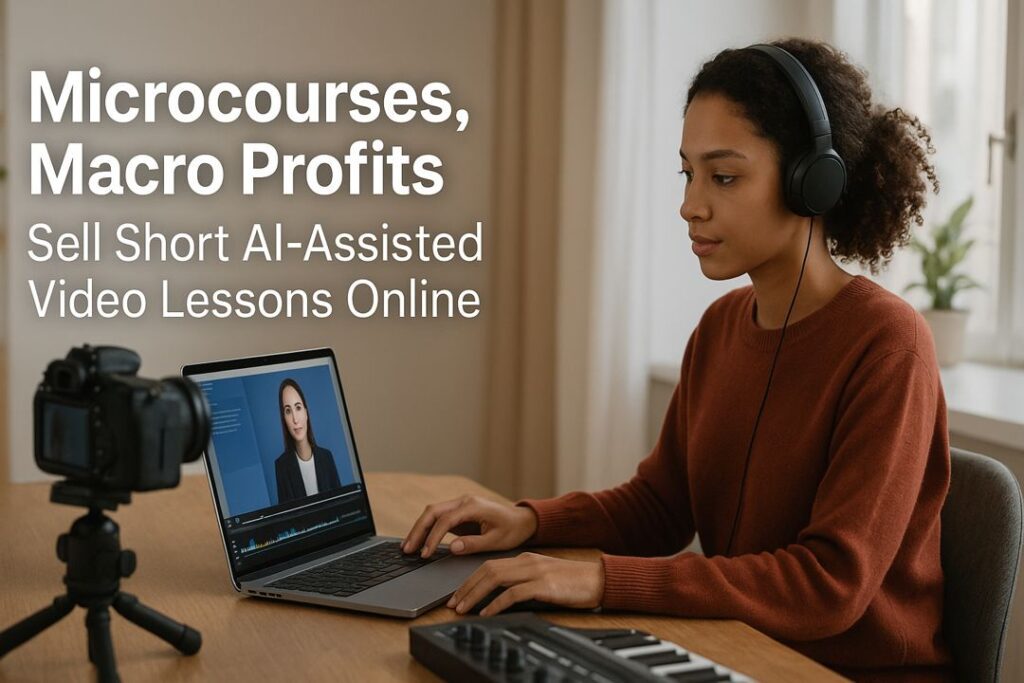Turn Your Expertise Into a Micro-Course: Launch in a Weekend
If you’ve ever thought about creating an online course but felt overwhelmed by the idea of building a 12-module program with slick videos, worksheets, and a $997 price tag… take a deep breath.
You don’t need any of that to start teaching — or earning.
What you need is a micro-course.
A micro-course is a short, focused learning experience that solves one specific problem for your audience. It’s small enough to create in a weekend but powerful enough to generate income, grow your authority, and become the foundation for bigger offers.
In this guide, I’ll walk you step by step through turning your expertise into a micro-course you can launch in just a few days. We’ll cover everything — from topic selection to pricing psychology to promotion strategies — so by the time Monday rolls around, you could have your first digital product live and ready to sell.

Why Micro-Courses Are the Perfect First Step
Traditional courses are big, heavy projects. They take months to produce, require expensive gear, and can feel risky if you don’t already know your audience will buy. Micro-courses eliminate all of that:
- Fast to create: You can outline, record, and publish in a single weekend.
- Focused: They solve one problem, not a dozen. Students love this because they get quick wins.
- Affordable for buyers: A $27 course is a much easier yes than a $997 course.
- Low risk for creators: You don’t have to spend weeks or thousands of dollars before testing the idea.
- Scalable: A micro-course can be a product on its own, a lead magnet for bigger offers, or a stepping stone to a larger course later.
In short: micro-courses are the fastest way to go from “thinking about launching” to “I have a product live and selling.”
Step 1: Pick a Problem Worth Solving 🎯
The #1 mistake most first-time course creators make is going too broad. A micro-course should solve one clear, urgent problem in under two hours of total learning time.
Questions to Ask:
- What do people constantly ask me about?
- What small skill or trick do I know that could save someone else time or money?
- Could I break this down into 3–5 short lessons?
Example Ideas:
- Blogging niche: “How to Write a Month of Blog Posts in 60 Minutes”
- Health niche: “15-Minute Morning Stretches for Desk Workers”
- Business niche: “Send Your First Invoice in Canva Without Confusion”
- Parenting niche: “Calm Bedtime Routines That Actually Work”
Notice how each one promises a clear, specific result. That’s the magic.
Step 2: Outline in 30 Minutes
Don’t overcomplicate your outline. Use the 3-to-5 Lesson Framework:
- Intro Lesson: Set expectations, explain what they’ll learn, and why it matters.
- Lesson 1: First step of the process.
- Lesson 2: Second step or main strategy.
- Lesson 3: Final step or wrap-up.
- Conclusion: Congratulate them, give action steps, and provide the next step (like another product or your newsletter).
Each lesson should be no more than 8–10 minutes if you’re doing video. Shorter is better.
Step 3: Choose Your Format
Your micro-course doesn’t need to look like it came out of Hollywood. Pick the format that matches your strength and your timeline:
- Video: Great if you’re comfortable teaching face-to-camera or doing screen share tutorials.
- Audio: Works like a private podcast — perfect for coaching-style lessons.
- PDF Guide: If you’re better at writing, a well-designed workbook can be the course.
👉 Pro Tip: You don’t need expensive gear. Your laptop webcam and built-in microphone are fine for a starter course. If you want smoother performance for recording and editing, the HP Pavilion 15 Laptop 💻 is a reliable, affordable choice for creators.
Step 4: Record and Edit Quickly
This is where most creators stall — they get perfectionist and never finish. Not you.
Recording Tips:
- Script bullet points, not word-for-word text.
- Record lessons back-to-back to stay in flow.
- Use free tools like Loom or Zoom to capture screen and audio.
- Film in a quiet, well-lit room. Natural light works wonders.
Editing Tips:
- Don’t worry about fancy transitions. Just trim the mistakes.
- Add simple intro/outro slides with your course title.
- Free software like iMovie (Mac) or Clipchamp (Windows) is enough.
Remember: done is better than perfect.

Step 5: Price Your Micro-Course
Pricing a small course can feel tricky. Too cheap and it looks low value, too expensive and people expect a full program.
The Sweet Spot: $7–$47
This range works because:
- It’s affordable for buyers.
- It positions your product as more serious than a freebie.
- It still earns you meaningful revenue per sale.
Pricing Psychology
- $7–$15: Impulse buy. Works well for lead-generation products.
- $27: The “sweet spot” — feels valuable but affordable.
- $47: Best for in-depth micro-courses with templates, worksheets, or bonuses.
👉 Bonus Tip: Anchor your price by showing what it replaces. Example: “For less than a single takeout lunch, you’ll finally set up your first email funnel.”
Step 6: Host Your Micro-Course
You don’t need a complex tech stack to deliver your content.
- Gumroad: Perfect for quick weekend launches. Upload your files, set a price, get a product page instantly.
- Podia: Good if you want to bundle multiple digital products later.
- Teachable: Great if you want progress tracking and a polished learning platform.
Choose the simplest platform that gets the job done. The goal this weekend is done, not perfect.
Step 7: Add E-E-A-T for Credibility
Even with a $27 product, buyers want to know they’re learning from someone trustworthy. Add Experience, Expertise, Authoritativeness, and Trustworthiness (E-E-A-T):
- Mention your personal background (“I’ve been blogging for 5 years and this is the system I use.”).
- Include screenshots or real examples.
- Add a short bio and photo on your course page.
- Be transparent about what the course covers (and doesn’t).
This not only improves sales but also makes your content more Google-friendly if you repurpose it into blog posts.
Step 8: Promote Your Micro-Course
A micro-course won’t sell itself. Here’s how to promote it — even on launch weekend:
Organic Traffic:
- Write a blog post related to your course topic and link to it.
- Share quick tips on social media, then invite people to “get the full system” in your course.
- Post in Facebook groups or communities (where allowed).
Email:
- If you already have a list, send a “Weekend Launch” email.
- Use urgency: “Enroll now, complete it by Monday.”
Paid Traffic:
- Run a small Facebook ad to your warm audience (followers, past visitors).
- Test a $20 budget just to see what happens.
Long-Term Promotion:
- Add links to your course in your email footer.
- Mention it in podcast interviews or YouTube videos.
- Pin it to the top of your social profiles.

Step 9: Gather Feedback and Improve
Your first version doesn’t have to be perfect — it just has to exist. Once students go through it:
- Ask them what they liked best.
- Find out where they got stuck.
- Add bonuses or clarifications where needed.
This feedback loop makes your micro-course stronger and more valuable over time.
Step 10: Measure Your ROI 📊
Don’t just look at sales — look at the big picture.
- Sales Revenue: Obvious, but important.
- Email Growth: How many buyers joined your list?
- Upsells: Did students take you up on a coaching call or template bundle?
- Testimonials: Every positive review is an asset for marketing future products.
Even if you only sell 10 copies your first weekend, you’ve proven people will pay for your knowledge. That’s huge.
Common Mistakes to Avoid
- Making it too long: If it feels like a full course, you’re doing too much. Keep it tight.
- Overproducing: Fancy graphics and perfect editing don’t matter. Clarity does.
- Underpricing to $1 or $2: This devalues your expertise. Free resources exist everywhere. Charge enough to be taken seriously.
- Waiting for “perfect”: Launch now, improve later.
Real-World Examples
- Case Study 1: A fitness blogger created “10-Minute Desk Stretches” as a $19 video course. She sold 60 copies in her first month just by emailing her list.
- Case Study 2: A food blogger packaged “5 Quick Dinners Under 20 Minutes” into a $27 PDF with recipes and grocery lists. It became her #1 income source.
- Case Study 3: A digital marketer built “Write Your First Ad in One Hour” as a $37 micro-course. It not only sold but led to $500+ coaching clients.
Product Spotlight
HP Pavilion 15 Laptop 💻
Don’t let slow tech hold you back. A reliable laptop that can handle screen recording, editing, and file uploads smoothly makes your weekend course creation stress-free. The HP Pavilion 15 is lightweight, powerful, and budget-friendly — perfect for new creators.
Shortcut Your Learning Curve
If you’ve never created a digital product before, you’ll save yourself tons of trial and error by joining Wealthy Affiliate.
Their training covers:

- Audience and keyword research.
- Affiliate marketing strategies.
- Building funnels that lead to your micro-course.
- Growing a long-term, profitable business around your content.
FAQs
Q: How long should a micro-course be?
Under 2 hours of total content. Students buy micro-courses for fast wins.
Q: How much should I charge?
$7–$47, depending on depth and bonuses.
Q: Can I launch with just a PDF?
Yes — if it delivers a clear, valuable outcome, a PDF is a valid micro-course.
Q: What if no one buys?
That’s feedback! Use it to refine your topic, adjust your promotion, or test different audiences.
Final Thoughts
The hardest part of course creation is getting started. That’s why micro-courses are so powerful — they lower the barrier to entry for both you and your students.
By focusing on one problem, keeping it short, and launching quickly, you can create a product this weekend that:
- Proves people will pay for your knowledge.
- Builds your authority in your niche.
- Generates income while opening doors to larger offers down the line.
So stop waiting for perfect. Pick a problem, outline three lessons, hit record, and launch. By Monday, you could officially call yourself a course creator. 🌟

Larry Mac
Hi there, and thanks for stopping by! My name is Larry, and I’m the voice behind 6fig.com. I search the Internet to try and find money-making opportunities to share.. Thanks for stopping by. Feel free to subscribe and comment. Thank You!
You Got This, I Learned these skills and more at Wealthy Affiliate. Hey, if this 65-year-old Grandfather can make money online, you can too!


